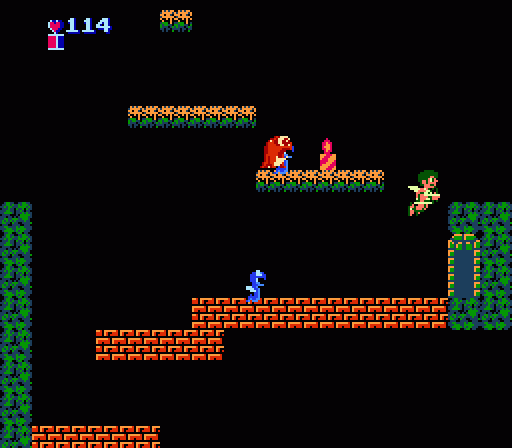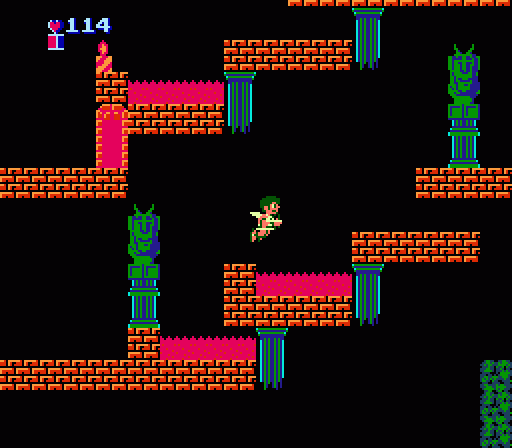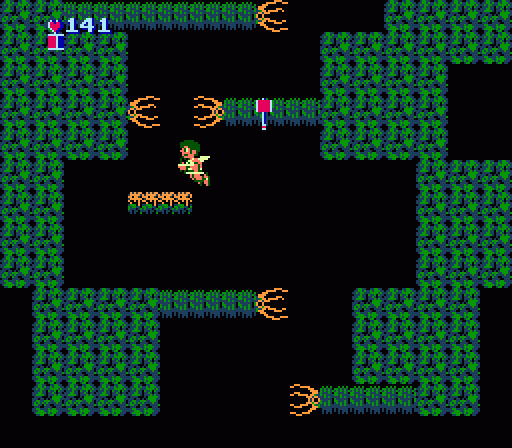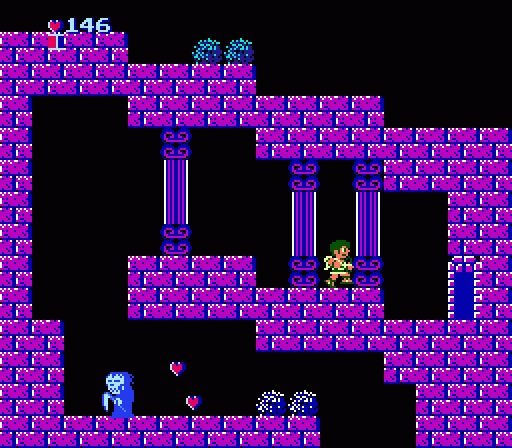Did you miss me? Alas, I had to take a break from 2 Dimensions because I was working on a massive freaking Sega Genesis anniversary tribute. As always, the challenge with this sort of thing is in writing something about a well-worn subject that hasn’t already been said to death. Despite the fact that they’re both incredibly lengthy retrospectives, I guess this one is kind of the opposite of my other big retrospective from this week.
Anyway.
Kid Icarus may do some unconventional things with its design, like make the first stage the hardest in the entire stupid game, but even its famously troubled development led by an inexperienced director observes basic rules of good sense. For example, we have World 1-3, in which only two minor new elements are introduced from the sandbox of the first two stages. Instead of continuing to throw unexpected challenges and concepts into the mix for players to contend with, World 1-3 effectively asks you to work your way through the rules and monsters you know arranged in a lengthy, difficult gauntlet.
Of course, it wouldn’t be Kid Icarus if some of those gauntlet scenarios weren’t a load of frustrating crap.

World 1-3 is much, much lengthier than the previous two stages; in fact, it’s about half again as long as 1-2. If you thought the first couple of worlds felt like a grueling grind, you’re in for a treat here. Some of the trickier enemies work their way into the standard formations of Shemums and Monoeyes, interrupting the predictable groups of four with random surprises. The most irritating of these, unsurprisingly, are the McGoos that unexpectedly but invariably pop out of the ground under your feet as you’re trying to draw a bead on Monoeye patterns midway through the level. Since they pop up in an area with little footing, they have a tendency to appear literally beneath Pit’s feet, meaning you almost certainly won’t notice them until you’ve taken damage. And even if you do spot them before it’s too late, they have a maddening tendency to materialize while you’re standing on thin platforms so that if you duck to avoid their projectiles you’ll slip through the platform and plunge to your death.
On one hand, I like seeing games combine mechanics and hazards in effective ways. On the other hand, these particular mechanics and hazards are both annoying, so it’s a sandwich of annoyance.

You don’t have to make it far before you come across the first new element in this stage: Lava. Or poison water. Or maybe it’s just wine with a bad attitude. Whatever the case, it communicates its nature pretty transparently: These are clearly pools of some sort of liquid in an angry shade of magenta. Even with the day-glo limitations of the NES color palette, hot pink water is something you’ll instinctively shy away from.
An interesting trait of Kid Icarus‘ death water: It’s not immediately harmful. If Pit falls in, he has about half a second to jump back out again before it begins injuring him. This works rather differently than Metroid’s acid and lava pools, which begin sapping Samus’ health the instant she makes contact, but it’s a nice touch of mercy. The game is so unforgiving about missing jumps that being extended this small perk in the event you bungle a leap feels almost uncharacteristically kind, as if someone wasn’t paying attention and forgot to ratchet up the jerk-o-meter to max.
But the damage delay makes a sort of sense versus Metroid’s mechanic, since Samus has a larger pool of health with more gradations than Pit. Her energy meter is divided by sets of 100 (or 99 for her base energy) and broken further into single digits, which begin ticking away as soon as you contact the liquid. Pit’s health is broken into sets of eight (or seven for his base energy), so once the lava starts chipping away at his health it goes pretty quickly. This is a small detail, but it is interesting to see how some of the same designers approached a common mechanic in two different contexts based on each game’s limitations.

The stage’s second new element is actually pretty similar to the first: Passive environmental hazards that progressively sap Pit’s health. In this case, they’re… spikes? Poison vines? Something. Anyway, they jut from the wall, and if you overlap them for more than a split second, Pit will take damage. In most cases they simply serve to make you more cautious about your jumps, though the few frames of mercy when you first make contact means you don’t have to avoid them entirely. You can brush along the tips of the spikes as you bound upward and the momentum of your leaps will allow you to clear the spikes before the damage has a chance to activate.
However, elsewhere, they create a more direct danger. Much of World 1-3 consists of moving platforms that traverse the screen horizontally, moving back and forth from edge to edge, and these spikes frequently appear at the ends of the platforms’ paths. If you simply ride the platforms back and forth, you’ll be dragged into the nettles… and the platforms’ movement pattern, which causes them to slow as they change direction, guarantee you’ll be stuck in the damage zone long enough to take potentially fatal damage. So you’re forced to move quickly on the moving platform sequences. A lot of the hazards in this stage feel unfair, but this one is actually pretty smart.

World 1-3 makes heavy use of Kid Icarus’ screen wrap mechanic, forcing you to advance by warping from one side of the screen to another. Generally this takes the form of obvious, stair-stepped level design that leaves you no other choice, but in other places you’re presented with huge empty gaps that can only be traversed by ducking back and forth. As ever, the warp effect can be advantageous for dodging foes (such as, say, when Commylooses approach from below as you’re trying to deal with a Grim Reaper), but there are also a few spots where the level designer decided to be nasty: From time to time, you can warp to the other side of the screen from a platform only to find there’s no corresponding platform on the opposite side. In which case you’ll step onto thin air and plunge to death below. Kind of a cheap move!
Another cheap thing about this stage is that enemies like to drop from above, and the point of the screen from which they drop changes as you scroll upward. You can’t always tell where they’re going to start falling from, and you’ll almost inevitably lose health to some random Shemum that appears right above you without warning. It’s this sort of thing, not the more predictable threats, that makes the length of this world so tiring.

Mitigating this stage’s difficulty and length is the fact that you should have been able to power up by now. Unless you’re playing carelessly, you should have been able to earn a strength upgrade in World 1-2, which turns Pit’s hair a nasty shade of green that NES developers generally avoided (the only other game I can think of where this color was applied to human forms were NPCs in Golgo 13: Top Secret Episode, and when your aesthetics resemble that game in the slightest you know you’ve made a horrible mistake). With that ugliness comes power, though, and an upgraded Pit can (for example) take out a Grim Reaper in five hits rather than 10 — a pretty significant improvement.
Shortly before the end of the stage, you’ll also come across one more room type: A challenge room, in which a god tests you by flinging a series of monoliths at you. If you can endure his “harsh training,” he’ll give you a choice of sacred treasure, which you’ll be able to activate once you gain a second health bar (if you haven’t already) and fill it to maximum. Which means you can’t really enjoy your new acquisition until World 2-1, since there’s nowhere to refill your health before the end of the stage, and sacred treasures are deactivated in the x-4 worlds.
“Alas, I had to take a break from 2 Dimensions because I was working on a massive freaking Sega Genesis anniversary tribute”
…which was killer. I really loved it.
Indeed. Very good work, compelling despite coming in knowing all the details.
I don’t remember Kid Icarus being this unfriendly, but that was over a decade ago when I was less clinical of games and more likely to use save states. I’ll have to go back to this sometime in the near future.
It’d be interesting to see an “Anatomy of a Game” of something that falls into kusoge territory - maybe Super Pitfall or the like (especially when compared to, say, Pitfall II) - to point out how such titles were so much the opposite of smart design as some of the titles you’ve done so far. Then again, I suppose Kid Icarus is sort of serving that purpose…
I just assumed it was you getting settled. And, you know, not trying to be a creeper, but I am hoping for some impressions of your new digs.